Human Ubc9 contributes to production of fully infectious human immunodeficiency virus type 1 virions
- PMID: 19640976
- PMCID: PMC2753122
- DOI: 10.1128/JVI.00237-09
Human Ubc9 contributes to production of fully infectious human immunodeficiency virus type 1 virions
Abstract
Ubc9 was identified as a cellular protein that interacts with the Gag protein of Mason-Pfizer monkey virus. We show here that Ubc9 also interacts with the human immunodeficiency virus type 1 (HIV-1) Gag protein and that their interaction is important for virus replication. Gag was found to colocalize with Ubc9 predominantly at perinuclear puncta. While cells in which Ubc9 expression was suppressed with RNA interference produced normal numbers of virions, these particles were 8- to 10-fold less infectious than those produced in the presence of Ubc9. The nature of this defect was assayed for dependence on Ubc9 during viral assembly, trafficking, and Env incorporation. The Gag-mediated assembly of virus particles and protease-mediated processing of Gag and Gag-Pol were unchanged in the absence of Ubc9. However, the stability of the cell-associated Env glycoprotein was decreased and Env incorporation into released virions was altered. Interestingly, overexpression of the Ubc9 trans-dominant-negative mutant C93A, which is a defective E2-SUMO-1 conjugase, suggests that this activity may not be required for interaction with Gag, virion assembly, or infectivity. This finding demonstrates that Ubc9 plays an important role in the production of infectious HIV-1 virions.
Figures
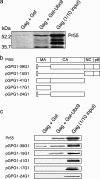
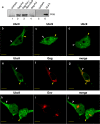
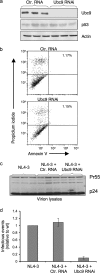
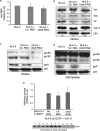

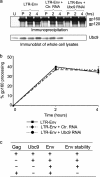

Similar articles
-
Human Ubc9 is involved in intracellular HIV-1 Env stability after trafficking out of the trans-Golgi network in a Gag dependent manner.PLoS One. 2013 Jul 8;8(7):e69359. doi: 10.1371/journal.pone.0069359. Print 2013. PLoS One. 2013. PMID: 23861967 Free PMC article.
-
HIV-1 Matrix Trimerization-Impaired Mutants Are Rescued by Matrix Substitutions That Enhance Envelope Glycoprotein Incorporation.J Virol. 2019 Dec 12;94(1):e01526-19. doi: 10.1128/JVI.01526-19. Print 2019 Dec 12. J Virol. 2019. PMID: 31619553 Free PMC article.
-
Characterization of human immunodeficiency virus type 1 Pr160 gag-pol mutants with truncations downstream of the protease domain.Virology. 2004 Nov 10;329(1):180-8. doi: 10.1016/j.virol.2004.08.010. Virology. 2004. PMID: 15476885
-
Exploring HIV-1 Maturation: A New Frontier in Antiviral Development.Viruses. 2024 Sep 6;16(9):1423. doi: 10.3390/v16091423. Viruses. 2024. PMID: 39339899 Free PMC article. Review.
-
Advances in HIV-1 Assembly.Viruses. 2022 Feb 26;14(3):478. doi: 10.3390/v14030478. Viruses. 2022. PMID: 35336885 Free PMC article. Review.
Cited by
-
SUMO-conjugating enzyme E2 UBC9 mediates viral immediate-early protein SUMOylation in crayfish to facilitate reproduction of white spot syndrome virus.J Virol. 2013 Jan;87(1):636-47. doi: 10.1128/JVI.01671-12. Epub 2012 Oct 24. J Virol. 2013. PMID: 23097446 Free PMC article.
-
RanBP2 regulates the anti-retroviral activity of TRIM5α by SUMOylation at a predicted phosphorylated SUMOylation motif.Commun Biol. 2018 Nov 15;1:193. doi: 10.1038/s42003-018-0198-0. eCollection 2018. Commun Biol. 2018. PMID: 30456314 Free PMC article.
-
How HIV-1 Gag Manipulates Its Host Cell Proteins: A Focus on Interactors of the Nucleocapsid Domain.Viruses. 2020 Aug 13;12(8):888. doi: 10.3390/v12080888. Viruses. 2020. PMID: 32823718 Free PMC article. Review.
-
Live cell visualization of the interactions between HIV-1 Gag and the cellular RNA-binding protein Staufen1.Retrovirology. 2010 May 10;7:41. doi: 10.1186/1742-4690-7-41. Retrovirology. 2010. PMID: 20459747 Free PMC article.
-
Human pathogens and the host cell SUMOylation system.J Virol. 2012 Jan;86(2):642-54. doi: 10.1128/JVI.06227-11. Epub 2011 Nov 9. J Virol. 2012. PMID: 22072786 Free PMC article. Review.
References
-
- Alroy, I., S. Tuvia, T. Greener, D. Gordon, H. M. Barr, D. Taglicht, R. Mandil-Levin, D. Ben-Avraham, D. Konforty, A. Nir, O. Levius, V. Bicoviski, M. Dori, S. Cohen, L. Yaar, O. Erez, O. Propheta-Meiran, M. Koskas, E. Caspi-Bachar, I. Alchanati, A. Sela-Brown, H. Moskowitz, U. Tessmer, U. Schubert, and Y. Reiss. 2005. The trans-Golgi network-associated human ubiquitin-protein ligase POSH is essential for HIV type 1 production. Proc. Natl. Acad. Sci. USA 102:1478-1483. - PMC - PubMed
-
- Argasinska, J., K. Zhou, R. J. Donnelly, R. T. Hay, and C. G. Lee. 2004. A functional interaction between RHA and Ubc9, an E2-like enzyme specific for Sumo-1. J. Mol. Biol. 341:15-25. - PubMed
-
- Babic, I., E. Cherry, and D. J. Fujita. 2006. SUMO modification of Sam68 enhances its ability to repress cyclin D1 expression and inhibits its ability to induce apoptosis. Oncogene 25:4955-4964. - PubMed
-
- Batonick, M., M. Favre, M. Boge, P. Spearman, S. Honing, and M. Thali. 2005. Interaction of HIV-1 Gag with the clathrin-associated adaptor AP-2. Virology 342:190-200. - PubMed
Publication types
MeSH terms
Substances
Grants and funding
LinkOut - more resources
Full Text Sources
Miscellaneous

